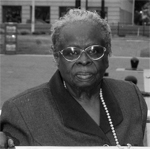
Interview with Mrs. Virtley A. Porter
September 2003
Written interview sent in by Mrs. Porter
Mrs. Virtley Porter was born on September 13, 1924. She attended local schools: Christian Home and Isle of Wight Training School, but spent much of her adult life away from the state before returning in retirement.
Q. Area of Isle of Wight where you grew up?
A. Christian Home Community.
Q. Number of sister and brothers?
A. Nine.
Q. Schools they attended?
A. Older ones attended Ebenezer Elementary School: younger ones, Christian Home.
Q. What county school(s) did you attend?
A. Christian Home Elementary School.
Q. What grades were taught there?
A. Primer-Seven.
Q. How many classrooms?
A. Two.
Q. How many teachers?
A. Two.
Q. What grades did you attend there?
A. Primer-Seven.
Q. What years?
A. I graduated in 1938.
Q. Who were some of your teachers?
A. Clarice Pretlow, Madeline White, Gladys Rainey, Kelly, Elgin Lowe.
Q. How did you get to and from school?
A. Walked.
Q. What jobs did you do before and after school?
A. Cleaned m y bedroom took turn in washing breakfast dishes, cleaning kitchen and packing lunch.
Q. What chores were done at school?
A. The larger children made fire, brought in wood, swept the floors, and washed board.
Q. How did the school day start?
A. Morning worship.
Q. What subjects did you cover?
A. Reading, writing, arithmetic, spelling, and geography.
Q. Any specific textbooks or readers? Where were they kept?
A. I remember the Primer. The other textbooks were for each subject. They were kept on my desk.
Q. How long was the school day?
A. 9 a.m. – 3 p.m.
Q. How long was the school year?
A. September- May.
Q. Where did you eat lunch and how long did you stop for lunch?
A. At my desk; about 30 minutes.
Q. When did you have recess and what did you do?
A. At noon, played dodge ball, also at lunchtime.
Q. How would you describe your school’s classroom?
A. Square room with black board and coatroom.
Q. How was the school heated in winter?
A. Wood stove.
Q. Were there restrooms?
A. Yes, outdoor toilets.
Q. Where was your water supply?
A. Pump, out back of school.
Q. How would you describe the teacher’s desk?
A. Not much different from today.
Q. Describe the student’s desk?
A. Ink well on top, a place for books.
Q. Were chalkboards used?
A. Yes, but they were called blackboards.
Q. What school supplies were used?
A. Writing books.
Q. Were teaching aids on the wall?
A. Eye chart, ABC chart, and writing chart.
Q. Lighting?
A. Oil lamps.
Q. Was there a cloakroom and or wall hooks for coats?
A. Yes.
Q. Describe what discipline and punishments were used in the classroom.
A. Teacher’s paddle; standing in a corner, if misbehaved.
Q. Are there any additional school experiences you would like to tell us about?
A. I attended high school from 1938-1942, Virginia State college (now Norfolk State University) 1942-1946, graduated with BS Degree; Guidance Counselor Certification, Hampton Institute (Hampton University) 1960. Additional study at Virginia State College, Cornell University and New York University. Retired after 39 years as an educator.
Q. Are there other early childhood memories you recall about growing up?
A. 4-H Club was an activity enjoyed by boys and girls. Attending the Tidewater Fair in the fall, Summer Revival, Sunday School Unions on fifth (5th) Sundays, Sunday School conventions in the summer.
Q. After attending school, what jobs, changes, or other experiences do you recall in the county?
A. When attending Isle of Wight Training, I stayed in the homes of family friends and relatives. Buses came later. Parents had to pay for transportation. I worked on the family farm while attending high school and college (during summers). After graduating from college (the following summer), I worked up north at a Jewish Camp.